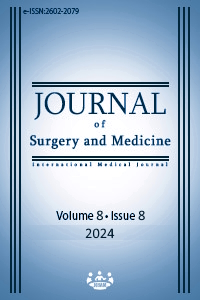Is hamstring muscle shortness responsible for low back pain in healthcare professionals?
Low back pain in healthcare professionals
Keywords:
hamstring shortness, low back pain, healthcare workersAbstract
Background/Aim: Low back pain (LBP) is a highly prevalent pathology affecting more than half of our population. The lumbar region inherently possesses a complex structure; therefore, dozens of causes for the clinical presentation of acute/chronic pain are present. We focused on the impact of hamstring shortness on LBP in healthcare workers/professionals who need to keep medical records and perform invasive procedures while traveling overwhelming distances in relatively small workplaces.
Methods: Our research was designed as a cross-sectional study and was conducted at Beykent University Hospital from March to April 2022. Sixty-two otherwise healthy healthcare workers/professionals aged 25–45 (both male and female) volunteered. Two equal groups with and without LBP were created. Oswestry disability index, Roland–Morris score, Quebec LBP questionnaire, Visual Analog Scale (VAS), active/passive knee extension, sit and reach, and forward bending tests were performed in each group. The collected data were statistically analyzed (confidence interval [CI]=20%; P<0.05).
Results: Active/passive knee extension, sit and reach, and toe touch tests were significantly related to Roland–Morris, Quebec, and Oswestry Disability Index questionnaires; thus hamstring muscle shortness was significantly related to chronic low back pain (P<0.05). Short hamstring muscle length could accurately reflect the lower test scores obtained by the female participants.
Conclusion: Hamstring muscle shortness could explain a significant proportion of low back pain in healthcare professionals.
Downloads
References
Shemory ST, Pfefferle KJ, and Gradisar IM. Modifiable risk factors in patients with low back pain. Orthopedics. 2016 May;39(3):413–6. doi: 10.3928/01477447-20160404-02. DOI: https://doi.org/10.3928/01477447-20160404-02
Hoy D, Bain C, Williams G, March L, Brooks P, Blyth F, et al. A systematic review of the global prevalence of low back pain. Arthritis and Rheumatism. 2012 June;64(6):2028–37. doi: 10.1002/art.34347. DOI: https://doi.org/10.1002/art.34347
Fatima G, Qamar M, Ul Hassan J, and Basharat A. Extended sitting can cause hamstring tightness. Saudi Journal of Sports Medicine. 2017;17(2):110. doi: 10.4103/sjsm.sjsm_5_17. DOI: https://doi.org/10.4103/sjsm.sjsm_5_17
Kanishka GK, Sandamali H, Weerasinghe I, Binduhewa L, Dilshara C, De Silva C, et al. Prevalence of hamstring tightness and associated factors among sewing machine operators. Ceylon Journal of Medical Science. 2020 Feb;56(1):24. doi: 10.4038/cjms.v56i1.4957. DOI: https://doi.org/10.4038/cjms.v56i1.4957
Cejudo A, Centenera-Centenera JM, and Santonja-Medina F. The potential role of hamstring extensibility on sagittal pelvic tilt, sagittal spinal curves and recurrent low back pain in team sports players: A gender perspective analysis. Int J Environ Res Public Health. 2021 Aug;18(16). doi: 10.3390/ijerph18168654. DOI: https://doi.org/10.3390/ijerph18168654
Jabbar M, Mustansar A, Zulfiqar F, Ayub T, Latif W, Laique T. Prevalence Of Hamstring Tightness Due To Prolonged Sitting Among Administrative Staff : Cross Sectional Study. P J M H S. 2021 March;15(3):1115-7.
Davis DS, Quinn RO, Whiteman CT, Williams JD, and Young CR. Concurrent validity of four clinical tests used to measure hamstring flexibility. J Strength Cond Res. 2008 March;22(2):583–8. doi: 10.1519/JSC.0b013e31816359f2. DOI: https://doi.org/10.1519/JSC.0b013e31816359f2
Nachemson A. Lumbar intradiscal pressure. Experimental studies on post-mortem material. Acta Orthop Scand Suppl. 1960;43:1–104. doi: 10.3109/ort.1960.31.suppl-43.01. DOI: https://doi.org/10.3109/ort.1960.31.suppl-43.01
Wilke HJ, Neef P, Hinz B, Seidel H, Claes L. Intradiscal pressure together with anthropometric data - a data set for the validation of models. Clinical Biomechanics. 2001;16. doi: 10.1016/S0268-0033(00)00103-0. DOI: https://doi.org/10.1016/S0268-0033(00)00103-0
Jackson AW and Baker AA. The relationship of the sit and reach test to criterion measures of hamstring and back flexibility in young females. Res Q Exerc Sport. 1986;57(3):183–6. doi: 10.1080/02701367.1986.10605395. DOI: https://doi.org/10.1080/02701367.1986.10605395
Mellin G. Correlations of hip mobility with degree of back pain and lumbar spinal mobility in chronic low-back pain patients. Spine. 1988 June;13(6):668–70. DOI: https://doi.org/10.1097/00007632-198813060-00012
Kuukkanen T and Mälkiä E, Effects of a three-month therapeutic exercise programme on flexibility in subjects with low back pain. Physiotherapy Research International. 2000;5(1). DOI: https://doi.org/10.1002/pri.183
Moreira RFC, Moriguchi CS, Carnaz L, Foltran FA, Silva LCCB, Coury HJCG. Effects of a workplace exercise program on physical capacity and lower back symptoms in hospital nursing assistants: a randomized controlled trial. Int Arch Occup Environ Health. 2021 Feb;94(2):275–84. doi: 10.1007/s00420-020-01572-z. DOI: https://doi.org/10.1007/s00420-020-01572-z
Denis A, Zelmar A, Le Pogam MA, Chaleat-Valayer E, Bergeret A, Colin C. The PRESLO study: Evaluation of a global secondary low back pain prevention program for health care personnel in a hospital setting. Multicenter, randomized intervention trial. BMC Musculoskelet Disord. 2012 Nov;13:234. doi: 10.1186/1471-2474-13-234. DOI: https://doi.org/10.1186/1471-2474-13-234
Barene S, Holtermann A, Oseland H, Brekke OL, Krustrup P. Effects on muscle strength, maximal jump height, flexibility and postural sway after soccer and Zumba exercise among female hospital employees: a 9-month randomised controlled trial. J Sports Sci. 2016 Oct;34(19):1849–58. doi: 10.1080/02640414.2016.1140906. DOI: https://doi.org/10.1080/02640414.2016.1140906
Meucci RD, Fassa AG, and Xavier Faria NM. Prevalence of chronic low back pain: Systematic review. Revista de Saude Publica (Universidade de Sao Paulo). 2015 Oct;49(1). doi: 10.1590/S0034-8910.2015049005874. DOI: https://doi.org/10.1590/S0034-8910.2015049005874
de Sousa CS, de Jesus FLA, Machado MB, Ferreira G, Ayres IGT, de Aquino LM, et al. Lower limb muscle strength in patients with low back pain: a systematic review and meta-analysis. J Musculoskelet Neuronal Interact. 2019 March;19(1):69–78.
Medeiros DM, Cini A, Sbruzzi AG, Lima CS, Influence of static stretching on hamstring flexibility in healthy young adults: Systematic review and meta-analysis. Physiother Theory Pract. 2016 Aug;32(6):438–45. doi: 10.1080/09593985.2016.1204401. DOI: https://doi.org/10.1080/09593985.2016.1204401
Neumann DA. A comparison between data from two intradiscal pressure studies. Kinesiology of the Musculoskeletal System. Mosby Elsevier. 2010;2(9):331.
Downloads
- 662 1168
Published
Issue
Section
How to Cite
License
Copyright (c) 2024 Javad Mirzazada, Elif Mirzazada
This work is licensed under a Creative Commons Attribution-NonCommercial-NoDerivatives 4.0 International License.
















